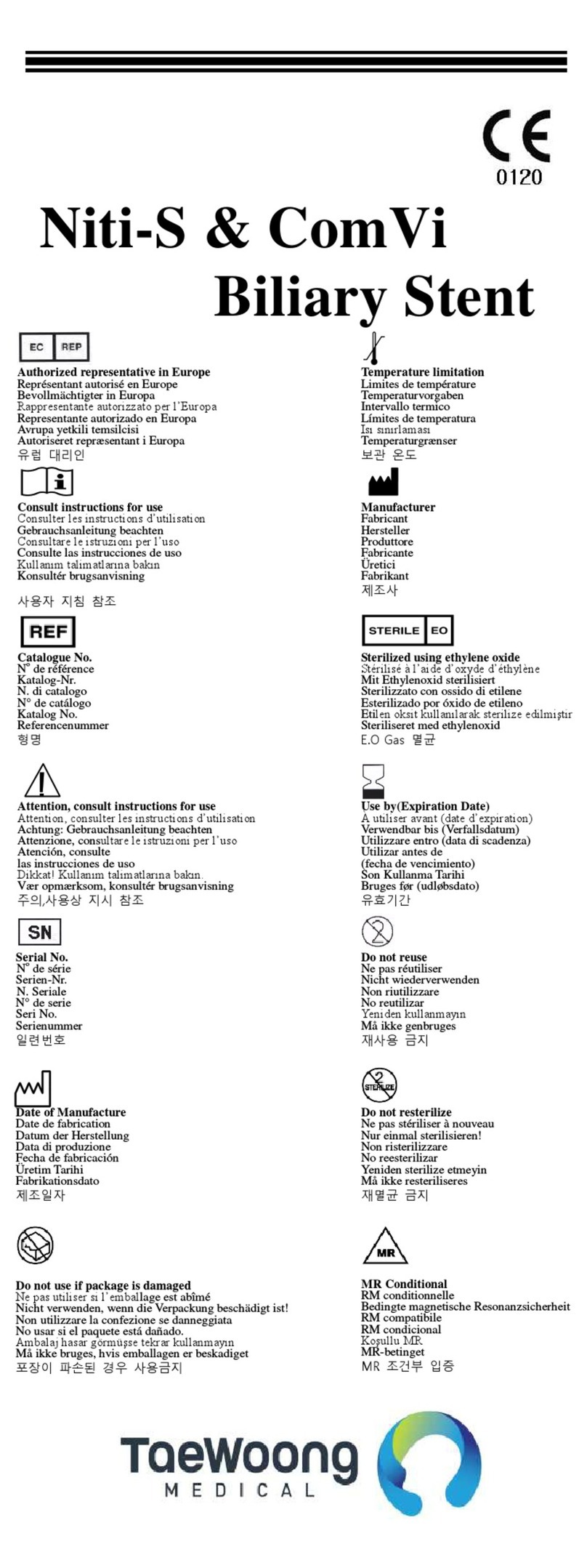
For OTW Type; Proximal release systems, the distal part of
outer sheath is pushed forward by immobilizing the Connector
in one hand, grasping the hub with the other hand, and gently
sliding the hub along the 2nd inner catheter towards the
Connector. Retraction of the outer sheath releases the stent
3. Indication for Use
The Niti-S & ComVi Enteral Colonic Stent is intended for
maintaining colon luminal patency in colon stricture caused by
intrinsic and/or extrinsic malignant and/or benign stricture.
WARRANTY
Taewoong Medical Co., LTD. warrants that reasonable care has
been applied within the design and subsequent manufacturing
process of this instrument. This warranty is in lieu of and
excludes all other warranties not expressly set forth herein,
whether expressed or implied by operation of law or otherwise,
including, but not limited to, any implied warranties of
merchantability or fitness for a particular purpose. Handling,
storage, cleaning and sterilization of this instrument as well as
other factors relating to the patient, diagnosis, treatment, surgical
procedures, and other matters beyond Taewoong’s control directly
affect the instrument and the results obtained from its use.
Taewoong’s obligation under this warranty is limited to the repair
or replacement of this instrument and Taewoong shall not be
liable for any incidental or consequential loss, damage, or expense
directly or indirectly arising from the use of this instrument.
Taewoong neither assumes, nor authorizes any other person to
assume for it, any other or additional liability or responsibility in
connection with this instrument. Taewoong assumes no liability
with respect to instruments reused, reprocessed or resterilized and
makes no warranties, expressed or implied, including but not
limited to merchantability or fitness for a particular purpose, with
respect to such instruments.
4. Contraindication
The Niti-S & ComVi Enteral Colonic Stent is contraindicated for,
but not limited to;
·Patient with ascites.
·Placement in polypoid lesions.
·Patient with bleeding disorder.
·Intra-abdominal abscess.
·Patients with coagulopathy.
·Strictures that do not allow passage of a guidewire.
·Any use other than those specifically outlined under indications
for use.
·Removal or repositioning of fully deployed uncovered/bare
Stents is contraindicated. (See Warnings).
·Suspected or impending perforation.
·Enteral ischemia.
·Recapturing a stent during its deployment is contraindicated.
5. Warnings
·The device should be used with caution and only after careful
consideration in patients with elevated bleeding times,
coagulopathies, or in patients with radiation colitis or proctitis.
·Chemoradiation therapy or radiotherapy alone may lead to
tumor shrinkage and subsequent stent migration.
·The stent contains nickel, which may cause an allergic reaction
in individuals with nickel sensitivity.
·Do not expose the introducer system to organic solvent (e.g.
Alcohol)
·Do not use with Ethiodol or Lipiodol contrast media.
·Niti-S Full Covered Stents can be removed where the treating
doctor’s clinical assessment of the stented stricture indicates the
Stent can be safely removed. Caution should be exercised in
deciding to and when removing the Stent.




























